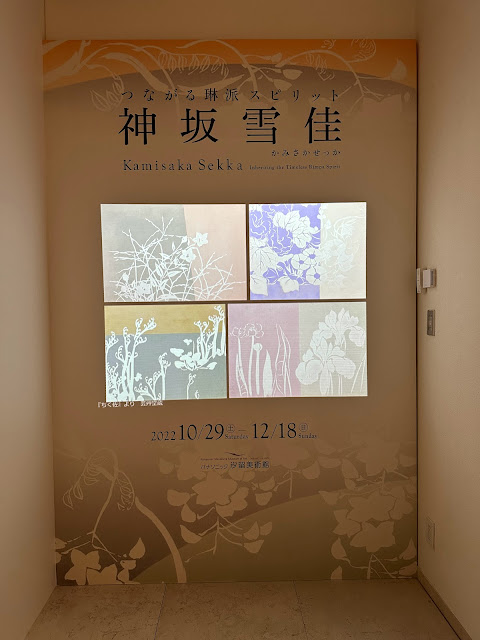最後の琳派、と言われることもある、神坂雪佳の展覧会。
琳派の豊富なコレクションで知られる細見美術館の作品が多く、展覧会の監修も細見美術館が担当しているとのこと。
最初のコーナーでは、本阿弥光悦と俵屋宗達の和歌巻の断簡、尾形光琳の陶器、渡辺始興や中村芳中の屏風絵、酒井抱一や中村其一の絵などが展示され、琳派のおさらいを行うようなイメージ。
パナソニック汐留美術館は、デザインや工芸などをテーマにした美術館。この展覧会では、神坂雪佳の絵画や図案集の他にも、神坂雪佳が図案を担当した工芸品の数々、蒔絵硯箱、赤楽茶碗、向付皿などが展示されていた。
それでも、この展覧会の一番の見どころは、日本の四季の情景、伝統的な物語のテーマ、色鮮やかな草花、愛らしい動物などの、神坂雪佳の図案集の数々だろう。
最後の広いスペースでは、神坂雪佳の多彩な作品、杜若、牡丹、紅葉、菊慈童、白凰などの絵に取り囲まれて、まるで神坂雪佳ワールドに迷い込んだようだった。
神坂雪佳は初めは京都四条派の絵師に絵を学んだので、そうした絵の中には琳派というよりは、明治・大正期によく見られた当時の日本画らしい、という印象の絵もあった。
琳派は狩野派や土佐派などとは違い、血のつながりのない人が、俵屋宗達や尾形光琳などを私淑した絵師が江戸時代を通じてそれを引き継いできた。
その意味では、神坂雪佳は琳派の正当な後継者、と言えるのかもしれない。
An exhibition of Sekka Kamisaka, sometimes called the last Rimpa school.
Many of the works are from the Hosomi museum, which is known for its rich collection of Rinpa paintings, and the Hosomi museum is also in charge of supervising the exhibition.
In the first corner, fragments of waka scrolls by Koetsu Honami and Sotatsu Tawaraya, pottery by Korin Ogata, folding screen paintings by Shiko Watanabe and Hochu Nakamura, and paintings by Hoichi Sakai and Kiichi Nakamura are exhibited. An image that is like a teaser.
The Panasonic Shiodome Museum of Art is an art museum with themes such as design and crafts. At this exhibition, in addition to Kamisaka Sekka's paintings and design collections, there were also many craft items designed by Kamisaka Sekka, such as maki-e inkstone boxes, red raku tea bowls, and mukozuke plates.
Still, the highlight of the exhibition is probably Sekka Kamisaka's collection of designs, including scenes from Japan's four seasons, traditional story themes, colorful flowers, and adorable animals.
In the large space at the end, I felt as if I had wandered into Sekka Kamisaka's world, surrounded by a variety of works by Sekka Kamisaka, such as Towaka, peonies, autumn leaves, Kikujido, and Hakuou.
Kamisaka Sekka first learned painting from Kyoto's Shijo school, so among those paintings, there are some that give the impression that they are more like Japanese paintings that were often seen in the Meiji and Taisho periods, rather than Rimpa. rice field.
Unlike the Kano and Tosa schools, the Rinpa school was inherited throughout the Edo period by painters who had no blood ties, such as Sotatsu Tawaraya and Korin Ogata.
In that sense, Kamisaka Sekka could be said to be the rightful successor of the Rinpa school.


コメント
コメントを投稿